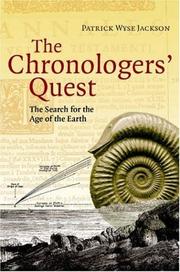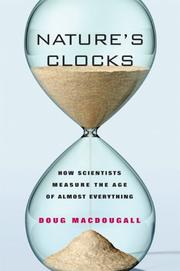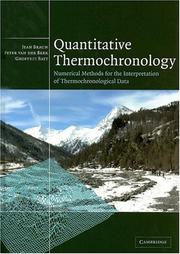| Listing 1 - 10 of 17 | << page >> |
Sort by
|
Book
ISBN: 1527556069 9781527556065 9781527554306 1527554309 Year: 2020 Publisher: Newcastle upon Tyne, England : Cambridge Scholars Publishing,
Abstract | Keywords | Export | Availability | Bookmark
 Loading...
Loading...Choose an application
- Reference Manager
- EndNote
- RefWorks (Direct export to RefWorks)
Book
ISBN: 9535116436 9535150510 Year: 2014 Publisher: IntechOpen
Abstract | Keywords | Export | Availability | Bookmark
 Loading...
Loading...Choose an application
- Reference Manager
- EndNote
- RefWorks (Direct export to RefWorks)
Chronology is the backbone of history, and there is a wise saying stating there is no history without a chronology. Earths evolutionary history is built up by geochronology, i.e. time benchmarks upon which the geological history is built up step by step over its total time period of about 4.5 billion years. The first marker in this history is the Jack Hills zircon from Australia dated at about 4.4 GA. The most detailed records come from seasonal changes within annual varves. Stratigraphy provides the basic chronological ordering of layers by layers, units by units, fossil assemblage by assemblage, varves by varves, growth zone by growth zone, etc. The radiometric techniques implied the introduction of absolute age determinations. This book includes a combination of methodological presentations and related case studies, from where we learn about practical problems and achievements. Therefore, the book should be of basic interest both for scientists in their practical in field and laboratory, as well as for general educational purpose.
Geochronometry. --- Dating of fossils --- Dating of rocks --- Fossils --- Geological chronometry --- Geological time --- Rocks --- Time measurements --- Dating --- Measurement --- Geology & the lithosphere
Periodical
Abstract | Keywords | Export | Availability | Bookmark
 Loading...
Loading...Choose an application
- Reference Manager
- EndNote
- RefWorks (Direct export to RefWorks)
Geology, Stratigraphic --- Paleontology --- Geochronometry --- Stratigraphie --- Paléontologie --- Géochronométrie --- Geochronometry. --- Geology, Stratigraphic. --- Paleontology. --- Quaternary Geologic Period. --- From 2 million years ago --- Fossilogy --- Fossilology --- Palaeontology --- Paleontology, Zoological --- Paleozoology --- Age of rocks --- Rocks --- Stratigraphic geology --- Dating of fossils --- Dating of rocks --- Fossils --- Geological chronometry --- Geological time --- Age --- Dating --- Measurement --- Historical geology --- Zoology --- Prehistoric animals in motion pictures --- Physical geology --- Time measurements --- Dynamic & Structural Geology
Periodical
ISSN: 18971695 17338387
Abstract | Keywords | Export | Availability | Bookmark
 Loading...
Loading...Choose an application
- Reference Manager
- EndNote
- RefWorks (Direct export to RefWorks)
Geochronometry --- Radioactive dating --- Radiocarbon dating --- Radioactive dating. --- Geochronometry. --- Radiocarbon dating. --- Archaeology --- Carbon dating --- Carbon-14 dating --- Dating, Radiocarbon --- Dating of fossils --- Dating of rocks --- Fossils --- Geological chronometry --- Geological time --- Rocks --- Age determination, Radiometric --- Dating, Radioactive --- Dating, Radiometric --- Fission dating methods --- Radiometric age determination --- Radiometric dating --- Dating --- Measurement --- Archaeological dating --- Time measurements --- Radioactivity
Book
ISBN: 9780444594259 9780444593900 9780444594341 0444594256 9780444594488 0444594485 044459390X 0444594345 9780444594358 0444594353 9781282234062 1282234064 9786613811806 Year: 2012 Publisher: [Oxford, U.K.]
Abstract | Keywords | Export | Availability | Bookmark
 Loading...
Loading...Choose an application
- Reference Manager
- EndNote
- RefWorks (Direct export to RefWorks)
Geological time --- Geochronometry --- Temps géologique --- Géochronométrie --- Geological time. --- Temps géologique --- Géochronométrie --- Age of rocks --- Geochronology --- Geochrony --- Rocks --- Time, Geological --- Chronology --- Historical geology --- Sequence stratigraphy --- Age --- Geochronometry. --- Dating of fossils --- Dating of rocks --- Fossils --- Geological chronometry --- Time measurements --- Dating --- Measurement
Book
ISBN: 9780826351593 9780826351616 0826351611 0826351611 1283636824 9781283636827 082635159X Year: 2012 Publisher: Albuquerque University of New Mexico Press
Abstract | Keywords | Export | Availability | Bookmark
 Loading...
Loading...Choose an application
- Reference Manager
- EndNote
- RefWorks (Direct export to RefWorks)
This edited volume offers archaeologists and archaeometrists the latest technical information, the fundamentals of provenance studies, instrumentation used in these investigations, and strategies for the dating and interpretation of archaeological materia
Hydration rind dating --- Obsidian --- Glassware, Ancient. --- Datation d'hydratation d'obsidienne --- Obsidienne --- Verrerie antique --- Obsidian. --- Hydration rind dating. --- Dating, Hydration rind --- Obsidian dating --- Obsidian hydration dating --- Archaeological dating --- Geochronometry --- Geology, Stratigraphic --- Iceland agate --- Hyalopsite --- Volcanic ash, tuff, etc. --- Ancient glassware

ISBN: 9780521813327 0521813328 9780511617782 9780511242090 0511242093 0511239521 9780511239526 0511247257 9780511247255 0511240457 9780511240454 051124097X 9780511240973 0511241496 9780511241499 1107159032 1280567813 9786610567812 0511318154 051161778X 9781107159037 9781280567810 6610567816 9780511318153 Year: 2006 Publisher: Cambridge Cambridge University Press
Abstract | Keywords | Export | Availability | Bookmark
 Loading...
Loading...Choose an application
- Reference Manager
- EndNote
- RefWorks (Direct export to RefWorks)
The debate over the age of the Earth has been ongoing for over two thousand years, and has pitted physicists and astronomers against biologists, religious philosophers against geologists. The Chronologers' Quest tells the fascinating story of our attempts to determine the age of the Earth. This book investigates the many novel methods used in the search for the Earth's age, from James Ussher and John Lightfoot examining biblical chronologies, Comte de Buffon and Lord Kelvin determining the length of time for the cooling of the Earth, to the more recent investigations of Arthur Holmes and Clair Patterson into radioactive dating of rocks and meteorites. The Chronologers' Quest is a readable account of the measurement of geological time. It will be of great interest to a wide range of readers, from those with little scientific background, to students and scientists in a wide range of the earth sciences.
Geochronometry. --- Geological time. --- Age of rocks --- Geochronology --- Geochrony --- Rocks --- Time, Geological --- Chronology --- Historical geology --- Sequence stratigraphy --- Dating of fossils --- Dating of rocks --- Fossils --- Geological chronometry --- Geological time --- Time measurements --- Age --- Dating --- Measurement

ISBN: 1281752622 1435684737 9786611752620 0520933443 9780520933446 9781435684737 9780520249752 0520249755 9781281752628 6611752625 Year: 2008 Publisher: Berkeley University of California Press
Abstract | Keywords | Export | Availability | Bookmark
 Loading...
Loading...Choose an application
- Reference Manager
- EndNote
- RefWorks (Direct export to RefWorks)
"Radioactivity is like a clock that never needs adjusting," writes Doug Macdougall. "It would be hard to design a more reliable timekeeper." In Nature's Clocks, Macdougall tells how scientists who were seeking to understand the past arrived at the ingenious techniques they now use to determine the age of objects and organisms. By examining radiocarbon (C-14) dating-the best known of these methods-and several other techniques that geologists use to decode the distant past, Macdougall unwraps the last century's advances, explaining how they reveal the age of our fossil ancestors such as "Lucy," the timing of the dinosaurs' extinction, and the precise ages of tiny mineral grains that date from the beginning of the earth's history. In lively and accessible prose, he describes how the science of geochronology has developed and flourished. Relating these advances through the stories of the scientists themselves-James Hutton, William Smith, Arthur Holmes, Ernest Rutherford, Willard Libby, and Clair Patterson-Macdougall shows how they used ingenuity and inspiration to construct one of modern science's most significant accomplishments: a timescale for the earth's evolution and human prehistory.
Geochronometry. --- Geological time. --- Radioisotopes in geology. --- Radioactive isotope geology --- Isotope geology --- Age of rocks --- Geochronology --- Geochrony --- Rocks --- Time, Geological --- Chronology --- Historical geology --- Sequence stratigraphy --- Dating of fossils --- Dating of rocks --- Fossils --- Geological chronometry --- Geological time --- Time measurements --- Age --- Dating --- Measurement
Book
ISBN: 1280126329 9786613530189 0226649393 9780226649399 9781280126321 9780226649375 0226649377 9780226649382 0226649385 Year: 2012 Publisher: Chicago London The University of Chicago Press
Abstract | Keywords | Export | Availability | Bookmark
 Loading...
Loading...Choose an application
- Reference Manager
- EndNote
- RefWorks (Direct export to RefWorks)
Whether the fossil record should be read at face value or whether it presents a distorted view of the history of life is an argument seemingly as old as many fossils themselves. In the late 1700s, Georges Cuvier argued for a literal interpretation, but in the early 1800s, Charles Lyell's gradualist view of the earth's history required a more nuanced interpretation of that same record. To this day, the tension between literal and interpretive readings lies at the heart of paleontological research, influencing the way scientists view extinction patterns and their causes, ecosystem persistence and turnover, and the pattern of morphologic change and mode of speciation. With Stratigraphic Paleobiology, Mark E. Patzkowsky and Steven M. Holland present a critical framework for assessing the fossil record, one based on a modern understanding of the principles of sediment accumulation. Patzkowsky and Holland argue that the distribution of fossil taxa in time and space is controlled not only by processes of ecology, evolution, and environmental change, but also by the stratigraphic processes that govern where and when sediment that might contain fossils is deposited and preserved. The authors explore the exciting possibilities of stratigraphic paleobiology, and along the way demonstrate its great potential to answer some of the most critical questions about the history of life: How and why do environmental niches change over time? What is the tempo and mode of evolutionary change and what processes drive this change? How has the diversity of life changed through time, and what processes control this change? And, finally, what is the tempo and mode of change in ecosystems over time?
Paleontology, Stratigraphic. --- Paleobiology. --- Fossils. --- Paleoecology. --- Geochronometry. --- Dating of fossils --- Dating of rocks --- Fossils --- Geological chronometry --- Geological time --- Rocks --- Time measurements --- Palaeoecology --- Ecology --- Paleobiology --- Paleontology --- Palaeobiology --- Biology --- Stratigraphic paleontology --- Dating --- Measurement

ISBN: 0521830575 9780521830577 9780521830577 9780511616433 9781107407152 9780511161711 0511161719 0511241585 9780511241581 0511160410 9780511160417 0511160984 9780511160981 0511616430 1280567554 9781280567551 1107148170 9781107148178 9786610567553 6610567557 0511313136 9780511313134 110740715X Year: 2006 Publisher: Cambridge Cambridge University Press
Abstract | Keywords | Export | Availability | Bookmark
 Loading...
Loading...Choose an application
- Reference Manager
- EndNote
- RefWorks (Direct export to RefWorks)
Thermochronology, the study of the thermal history of rocks, enables us to quantify the nature and timing of tectonic processes. First published in 2006, Quantitative Thermochronology is a robust review of isotopic ages, and presents a range of numerical modeling techniques to allow the physical implications of isotopic age data to be explored. The authors provide analytical, semi-analytical and numerical solutions to the heat transfer equation in a range of tectonic settings and under varying boundary conditions. They then illustrate their modeling approach built around a large number of case studies. The benefits of different thermochronological techniques are also described. Computer programs on an accompanying website at www.cambridge.org/9781107407152 are introduced through the text and provide a means of solving the heat transport equation in the deforming Earth to predict the ages of rocks and compare them directly to geological and geochronological data. Several short tutorials, with hints and solutions, are also included.
Earth temperature. --- Geochronometry. --- Heat --- Plate tectonics. --- Radioactive dating. --- Transmission. --- Tectonics, Plate --- Geodynamics --- Heat transfer --- Thermal transfer --- Transmission of heat --- Energy transfer --- Ground temperature --- Surface air temperature of the earth --- Surface temperature of the earth --- Temperature --- Age determination, Radiometric --- Dating, Radioactive --- Dating, Radiometric --- Fission dating methods --- Radiometric age determination --- Radiometric dating --- Geochronometry --- Radioactivity --- Dating of fossils --- Dating of rocks --- Fossils --- Geological chronometry --- Geological time --- Rocks --- Time measurements --- Measurement --- Dating
| Listing 1 - 10 of 17 | << page >> |
Sort by
|

 Search
Search Feedback
Feedback About UniCat
About UniCat  Help
Help News
News